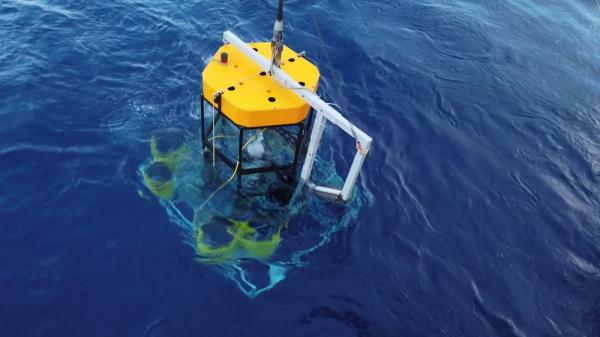The reporter learned from Shanghai Jiao Tong University on the 17th that as a pre-research demonstration project of the "Sea Bell Plan", the "Sea Bell Pathfinder" sea test team recently successfully deployed several sets of self-developed experimental instruments in the predetermined sea area and collected precious data, which verified the feasibility of the pre-selected sea area as a candidate site for neutrino telescopes. In addition, the team also successfully deployed submersible targets that can monitor the submarine flow field, biological activities, sediments and test telescope components for a long time, providing a basis for the subsequent telescope array design and long-term operation and maintenance.
The "Hailing Project" aims to explore the construction of China's first deep-sea neutrino telescope, explore the extreme universe by capturing neutrinos from high-energy celestial bodies, build a complete multi-messenger astronomical network in China, promote cutting-edge cross-cutting research in particle physics, astrophysics, geophysics, marine geography, marine life, etc., and has the great potential to breed a number of original scientific discoveries.

It is understood that the "Hailing Plan" is led by the Li Zhengdao Research Institute of Shanghai Jiao Tong University, which integrates the cutting-edge research advantages and strong engineering capabilities of Shanghai Jiao Tong University in physics, astronomy, marine engineering, marine science, materials, electronic information and other disciplines. The chief scientist is Xu Donglian, a scholar of Li Zhengdao.
Neutrinos are one of the basic units that make up the universe and the most numerous particles in the universe. It is not charged and interacts with matter extremely weakly, like a ghost, and extremely difficult to catch. Neutrinos were first observed experimentally in 1956. At present, the known neutrinos include three types: electron neutrinos, Miu neutrinos, and pottery neutrinos. Due to the quantum effect, neutrinos can be converted to each other during space-time propagation, similar to the face-changing performance of Sichuan opera, which is the famous neutrino oscillation phenomenon, by building a detector to study the oscillation behavior of neutrinos, humans can partially glimpse the basic laws of the formation of matter in the universe.
Because of the strong penetration of neutrinos, they can easily escape extreme, dense celestial environments, while carrying information on violent physical processes, making them ideals for studying the extreme universe. As early as 1912, physicists found that the Earth's atmosphere continued to be bombarded by high-energy ions (cosmic rays) in space, but its origin is still a mystery due to the deflection of cosmic rays in the direction of the magnetic field in interstellar propagation. Once the neutrinos produced by cosmic ray reactions are detected, they can be traced back to the source. Therefore, the century-old puzzle of the origin of cosmic rays can be solved with a single solution by detecting neutrino sources.
Xu Donglian said that the idea of neutrino astronomy originated in 1960 when scientists proposed to build an array of Cherenkov light detection elements in the deep sea or lake. Ice Cube, the most well-known neutrino telescope in the world, was built in the Antarctic ice in 2010. In 2013, Ice Cube detected for the first time a diffuse high-energy neutrino stream from beyond the earth, but this neutrino stream showed no signs of agglomeration, nor did it explicitly point back to any known celestial source, and if it is to effectively find the celestial source of high-energy neutrinos, it is still necessary to improve the detection sensitivity of the next generation of neutrino telescopes. At present, Europe and the United States are actively preparing to build a second-generation neutrino telescope with greatly optimized performance, which is expected to be completed around 2030, when there may be a major breakthrough in the field of neutrino astronomy.
"We have explored the construction of China's first deep-sea neutrino telescope, filled the gap in this field in China, and actively responded to the call put forward by the state to 'deploy a number of forward-looking, strategic and basic cutting-edge technology research and development projects' and 'actively seize the commanding heights of science and technology in the fields of deep sea, deep space, deep earth and deep blue'." Xu Donglian said.
Xu Donglian is a young scholar who has been active in the field of neutrino astronomy in recent years. In September 2018, Xu Donglian returned to China to join the Lee Zheng Dao Research Institute. In November of the same year, its "Neutrino Astronomy Research" project was supported by the "Overseas High-level Young Talents Special Project", mainly carrying out the site selection of neutrino telescopes and the research and development of detector prototype prototypes. The project continues to attract experts from Shanghai Jiaotong University and other universities and scientific research institutions in related fields. In August 2020, Xu Donglian officially proposed the construction planning and action plan of the South China Sea Neutrino Telescope - "Seabell Plan" at the National High Energy Physics Development Strategy Seminar (Qingdao).
Source: Xinhua News Agency